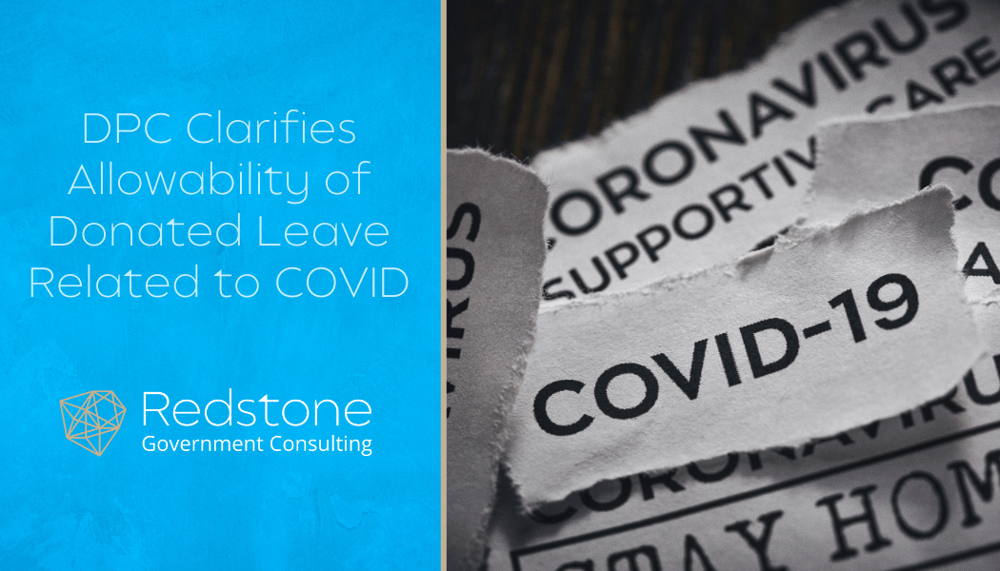
Let us Set the Stage
On June 11, 2020, the Internal Revenue Service (IRS) put out a Notice (2020-46) that allowed employees to donate unused leave to charitable groups supporting the COVID-19 National Emergency. Under the leave-based donation program, employees can elect to forgo vacation, sick, or personal leave in exchange for cash payments that the employer makes to charitable organizations. The notice provides that employee’s donation of leave will not be taxable income to the employee, however the employer will still treat the cost of the leave granted to the employee as either ordinary and necessary business expense or a charitable contribution. This applies to donations made before the end of the 2020 calendar year.
An excellent way of allowing individuals to help others through this very complex and tying time in the world.
So, Why Would DPC Have to Issue Guidance?
Our favorite DCAA auditors are out there with the idea that rules are rules and the Government’s intent to drive support to those that need it during the COVID-19 National Emergency cannot change those rules. FAR 31.205-8 states: “Contributions or donations, including cash, property and services, regardless of recipient, are unallowable, except as provided in 31.205-1(e)(3).” The FAR 31.205-1(e)(3) exception relates to “costs of participation in community service activities.” This has always been interpreted to make allowable the cost of the contractor supporting things like blood drives, but not any cash payments that the employer makes to charitable organizations. Based on our experience with DCAA auditors, they are not very likely to open their aperture to view the IRS notice as creating any possible allowable cost on Government contracts. That is without specific direction from above – The top cover they think they need.
The DPC Guidance
On October 14, 2020, Acting Principal Director, Defense Pricing and Contract (DPC), Mr. Kim Harrington issued a memorandum to specifically state: “Payments for vacation and personal [leave], but not for sick leave, represent an allowable compensation cost under Federal Acquisition Regulation (FAR) 31.205-6, ‘Compensation for Personal Services,’ rather than an unallowable contribution under FAR 31.205-8, ‘Contributions or Donations.’” The memorandum places a limit on the guidance that this cost allowability treatment only applies until the end of the 2020 calendar year. While, at least, this is in place for now.
Wait a Minute – Is There a Little Meat on this Bone for the Auditors?
Why yes, there is. The guidance excludes employee donated “sick leave” from allowability. While DPC provides no explanation for not including sick leave as allowable along with vacation and personal leave, we believe it is related to the accounting treatment applied by many contractors. Vacation and personal leave expense is normally accrued as an expense when earned by the employee to match the expense to the cost accounting period in which the contractor became liable to pay it or allow the employee to take the leave. For sick leave, many contractors expense this category of leave when taken by the employee, and do not accrue for this expense throughout the year. Again, this is our best guess.
Regardless of how you account for sick leave, our friendly DCAA auditors have another rule to apply and are going to want to see that you accounted for any employee donated sick leave as unallowable.
Redstone GCI is available to assist contractor’s in assessing their incurred cost, including this unique leave situation, as to allowable or unallowable. Redstone GCI assists contractors throughout the U.S. and internationally with understanding the Government’s expectations in applying FAR Part 31, Cost Principles.


 John is a Director with Redstone Government Consulting, Inc. providing government contract consulting services to our clients primarily related to the DFARS business systems, CAS Disclosure Statements, and DCAA/DCMA compliance preparation, advisory, and defense. Prior to joining Redstone Government Consulting, John served in a number of capacities with DCAA/DCMA for more than 30 years. Upon his retirement, he was based in Texas as an SES-level Corporate Audit Director for DCAA, managing a staff of 300 auditors at one of the largest DOD programs. Professional Experience John began his career in the late 80s working in the Clearwater, FL audit office and over the next three decades he progressed through a number of positions within both DCAA and DCMA with career highlights as DCAA Program Manager at Ft. Belvoir, Chief of Technical Programs Division, Deputy Assistant Director-Policy, Director of the DCMA Cost and Pricing Center, the SES-level Lockheed Martin Corporate Audit Director, and Director of Integrity and Quality Assurance. John’s three decades of experience in performing and leading DCAA auditors and DCMA reviewers provides a wealth of expertise to our clients. John’s role, not only in the performance of audits, but also in the development of audit policy affords him unique insights into the defense of audit findings and the linkage of audit program steps to the underlying regulatory framework. He is an expert in FAR, DFARS, and other agency acquisition regulation, as well as a subject matter expert in the Cost Accounting Standards having reviewed and provided audit feedback on many of the largest and most complex cost accounting practices during his tenure with the DCAA. John’s tenure with DCAA and DCMA came at a critical time during each agency’s history where a number of changes were occurring such as the response to the ICS backlog, development of audit approaches to the DFARS Business Systems and implementation of new audit initiatives as a result of Congressional oversight through the NDAA process. John’s leadership at the DCMA Cost & Pricing center saw oversight of all major DOD pricing actions, leadership of should cost review teams, the Commercial Pricing group and many other areas of strategic value to our clients. His involvement in these and other Agency initiatives is of great value to our clients due to his in depth understanding of DCAA and DCMA’s internal policy directives. Education John holds a Master of Business Administration and a B.A. in Accounting from the University of South Florida. Certifications Certified Information Systems Auditor State of Alabama Certified Public Accountant
John is a Director with Redstone Government Consulting, Inc. providing government contract consulting services to our clients primarily related to the DFARS business systems, CAS Disclosure Statements, and DCAA/DCMA compliance preparation, advisory, and defense. Prior to joining Redstone Government Consulting, John served in a number of capacities with DCAA/DCMA for more than 30 years. Upon his retirement, he was based in Texas as an SES-level Corporate Audit Director for DCAA, managing a staff of 300 auditors at one of the largest DOD programs. Professional Experience John began his career in the late 80s working in the Clearwater, FL audit office and over the next three decades he progressed through a number of positions within both DCAA and DCMA with career highlights as DCAA Program Manager at Ft. Belvoir, Chief of Technical Programs Division, Deputy Assistant Director-Policy, Director of the DCMA Cost and Pricing Center, the SES-level Lockheed Martin Corporate Audit Director, and Director of Integrity and Quality Assurance. John’s three decades of experience in performing and leading DCAA auditors and DCMA reviewers provides a wealth of expertise to our clients. John’s role, not only in the performance of audits, but also in the development of audit policy affords him unique insights into the defense of audit findings and the linkage of audit program steps to the underlying regulatory framework. He is an expert in FAR, DFARS, and other agency acquisition regulation, as well as a subject matter expert in the Cost Accounting Standards having reviewed and provided audit feedback on many of the largest and most complex cost accounting practices during his tenure with the DCAA. John’s tenure with DCAA and DCMA came at a critical time during each agency’s history where a number of changes were occurring such as the response to the ICS backlog, development of audit approaches to the DFARS Business Systems and implementation of new audit initiatives as a result of Congressional oversight through the NDAA process. John’s leadership at the DCMA Cost & Pricing center saw oversight of all major DOD pricing actions, leadership of should cost review teams, the Commercial Pricing group and many other areas of strategic value to our clients. His involvement in these and other Agency initiatives is of great value to our clients due to his in depth understanding of DCAA and DCMA’s internal policy directives. Education John holds a Master of Business Administration and a B.A. in Accounting from the University of South Florida. Certifications Certified Information Systems Auditor State of Alabama Certified Public Accountant